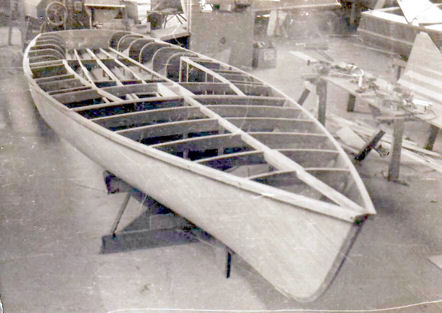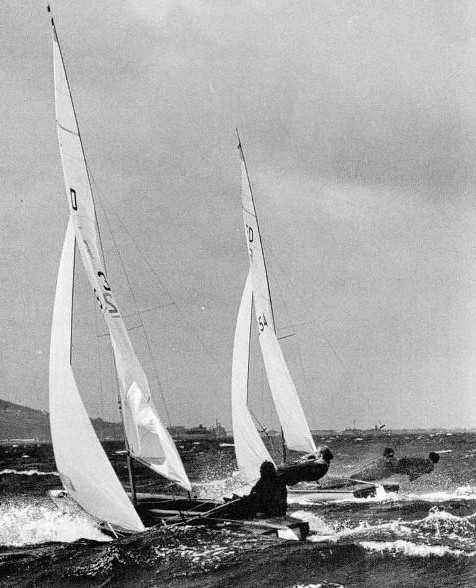The Olympic Games committee had at last made up its mind on the next two man Olympic sailing class. There had been a lot of rivalry between the 505s and Flying Dutchman class, and the 505 had been tipped to win selection.
We had already started building the 505s with an initial order of six from a group at the Royal Brighton Yacht club. It was rather a surprise when the Dutchman was selected. This was a big un-ballasted boat at twenty feet long with nearly 20 sq meters of sail. For a two man crew it appeared to be a difficult boat to sail. However, because it now had Olympic status, there was a lot of interest and we were swamped with requests to build them.
It took some weeks for a set of plans and metal templates to come out from Holland, and by the time they had arrived we already had tentative orders. The rules for this class were very strict and the minimum weight of 160kg (if I remember correctly) appeared difficult to achieve. The hull shape had a tolerance of only plus or minus 5mm from the measuring templates.

A popular version of the deck layout, with rounded deck aft for the helmsman, and
a flat section for the forward hand to work off when using the trapeze.
The first boats we built were a little overweight and it was necessary to reduce the hull thickness from 6mm to 5mm to achieve the minimum weight. Also the interior framing timbers had to be carefully selected to keep weight down. On reflection reducing the hull thickness to help save a few kilos may have been a mistake. I concluded later that the boats with the stiffer bottoms tended to plane a little earlier than the boats that were lighter and had movement in the bottom, and a boat that commenced planing a little earlier had a big advantage.
A lot of top helmsmen from the popular classes that had Olympic aspirations turned to the FDs, and it was, I think, a turning point in sailing in Australia. We built forty-odd boats that year, and a total of some one hundred and fifty over the next three years, and even exported some to Canada and New Zealand.
This was the first modern lightweight Olympic class of the era, and it replaced the old 12sq m heavy-weight Sharpie. It was then quite economical to build, and obviously would be fast. In fact the first batch of hulls we built only cost forty-nine pounds.
Mostly the boats did not sail in club races. They were housed at home, and tended to travel to host clubs that sponsored races for them, and it was the first time that sailing boats that big were to be seen being trailed from venue to venue.
As we were building these boats I decided to have a change and give the FD a try. I had a mate who I thought would make a good crew. He didnít know a lot about sailing, but was a good footballer. He was around six foot three, fourteen stone and very fit. Chris was keen to give it a go.
It was obvious from the start that tuning the Flying Dutchman was not going to be easy, considering that in the early races the fleet was so strung out. There was one factor that few had come across in Australia before; we had been building hollow spruce masts for these boats. and little attention in those days was given to the need for a sail that matched the mast. It was critical on these boats, seeing that they were generally over-canvassed in our normal wind conditions, and the mast had to be able to bend at just the right time, and the right amount, to flatten the sail when the boat was over-pressed.

FDs in a strong breeze! Note the mast bend, and how the mainsail has flattened off at the top.
The leach has opened up, and the big overlapping headsail is back-winding the mainsail.
The mainsheet is on hard and sheeted wide.
The usual practice on other boats had been, when over-powered, to ease the main, but on a FD as soon as the mainsail sheet was eased, the big overlapping headsail luff went slack and made that sail even fuller, which in turn back-winded the mainsail badly. At first, our mast was much too stiff and it was noticeable that a lot of other boats had the same problem. Several times after a heavy day I spent time planing some off the mast until one night I got quite a shock when I planed right through the wall. I had planed the sides so thin that I could push them in with my finger and the mast was still too stiff, so we needed a smaller section to make a mast flexible enough.
I built a new mast of a smaller section all round, and on our first tryout in a moderate breeze the mast bent too much too soon, and I spent a lot of time gluing veneer over the weak sections to stiffen it up again.
Another problem was which system to use for setting the spinnaker. Really it needs three pairs of hands to handle a spinnaker on a boat using a trapeze. I remember someone making a kind of apron affair with a big pocket in front to hold the sail, and the forward hand set it while out on the trapeze. Another boat tried the helmsman using the trapeze while the forward hand stayed inboard. Whatever you tried you were two hands short.
At last we had worked our way up to the front half of the fleet, but the best boats appeared to have mastered the knack of getting their boats to occasionally plane on the wind, and the gap between the best boats and the also-rans widened again.
Some owners started to give up as it all became too much. A local teenager, whose politician father bought him a boat against our advice, pressed his son so hard to sail it that he became so scared and depressed that he committed suicide.
The time came for the trials for the 1960 Rome Olympics and boats arrived from all over Australia. We considered that we were going well enough to give it a try. I donít think that many were really prepared for the tough series that had been planned.
We had been lectured before hand by one of our most experienced Olympians and Americas cup helmsmen. Jock Sturrock and I still remember his final words of advice, ďIn the Olympics if you see a competitor with his head down you kick it before he kicks you, it is no longer a sport itís a fight!Ē
Rolly Tasker from WA had represented Australia four years before at the Melbourne Olympics and had won Silver in the 12 sq metre Sharpie class. He arrived with a new boat he had built himself, and an amazing amount of gear. Rumour had it that he had four complete sets of gear, four masts and four suits of sails, that he had made to suit various conditions, and other spare gear. He set up his boat as far down the beach as he could get, and had the other competitors running down the beach to see what he was doing.
His campaign had already started!
Rolly easily won the series and went on to represent Australia, and there was a general feeling that would win gold. He was so much better than the rest of us, but the best he could do in the Olympics was 19th. Australia still had a long way to catch up.
Interest in the Flying Dutchman started to decline. To compete on equal terms meant spending a lot of money on the new alloy imported masts and more suits of sails and gear, and in reality the average good crews were simply not good enough.
At this time we had also started building Flying Fifteens and I found them much more to my liking. At least you could take a friend or two out for a dayís sailing, and although the competition was keen, keeping up with the fleet did not break the bank.
After all, we had not tamed the Dutchman; the "Flying Dutchman" had tamed us.
Of the original group of owners some persisted and unlocked the boats secrets. In 1964 John Dawe to his credit persisted, and represented Australia in Japan and finished a creditable 14th.